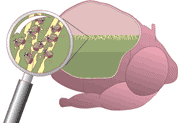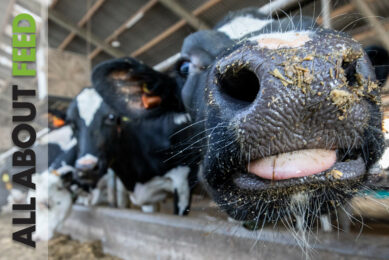Rumen rumour

Cattle and other ruminants are markedly different from monogastric animals, such as man, in that they have an additional organ, the rumen, at the beginning of the gastrointestinal tract. But the rumen is a complex organ and needs special attention.
The rumen allows ruminants to extract and absorb energy from fibrous plant material not otherwise available to mammalian enzymes. Additionally, the microbial protein, produced as a by product of this digestion, provides the host with much of its protein needs. The make sure the cows can perform well, the rumen needs to be in a good condition. In other words, it all starts in the rumen!
What is a healthy rumen?
Keeping the rumen healthy and in balance means that fibre will be digested at a maximal rate and feed intake will be maximized as well. An optimal rumen activity is characterized by:
- Powerful and frequent rumen contractions
- A pH of the rumen fluid of about 6.4 (not lower than 6)
- An optimum fermentation
- A high digestion of cell wall material
- A high passage rate from the rumen
- The existence of a ‘structure layer’ in the rumen
- A maximum microbial protein production
It starts with the fibre
To prevent problems in the rumen it all starts with a diet that contains enough fibrous material. Enough fibres make sure that the feed remains longer in the rumen – so that they are longer exposed for the rumen bacteria and thus better fermentation. More fermentation means more volatile fatty acids (VFA) production and a lower pH.
Fibres make sure that the cow produces enough saliva to buffer the rumen. A cow produces around 200-300 litres of saliva per day, containing around 10 grams of the buffer Natrium carbonate per litre. A too low pH of the rumen can cause serious problems for the animal such as rumen acidosis. This is paired with the production of volatile fatty acids and heights in lactic acid concentrations in the rumen.
The symptoms of less severe acidosis include: drop in milk fat content, drop in feed intake, drop in milk production. The manure is greenish and contains a lot of water. Acute (severe) acidosis is marked by diarrhoea, muscle shaking, fast hart beat and no rumen contractions and a severe drop in milk production. Other parameters, which can disturb the rumen fermentation, are a high fat content in the diet or a too high level of high fermentable carbohydrates in the feed.
DDGS effects on the rumen
The by product from the ethanol industry – Dried Distillers Grains is a valuable feed for both feedlot and dairy cattle. In North America, over 80% of DDGS is used in ruminant diets. More alternative feed ingredients enter the market, but what are the effects on the rumen? A study done by the K-state University in the US (Drouillard, 2008) looked at the effects of feeding this product on ruminal metabolism among others. The author showed that heifers fed DDGS as a partial replacement for steam-flaked corn had similar growth than animals that did not receive DDGS.
Feeding DDGS decreased ruminal pH and ruminal ammonia concentrations, and digestion of dry matter and organic matter were less compared to diets without DDGS. The decrease in digestibility was largely attributable to poorer digestion of crude protein and, to a lesser extent, a reduction in starch digestion.
To make sure that rumen remains healthy and use of alternative ingredients it is therefore important to fine tune the nutritional values of by products such as DDGS and to make sure the animals receive enough fibrous material in their diet. Got some more rumen rumour or want to add to this topic, please leave a comment!
[Photo courtesy: deLaval]











